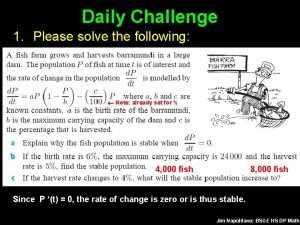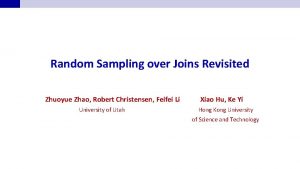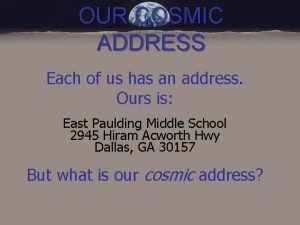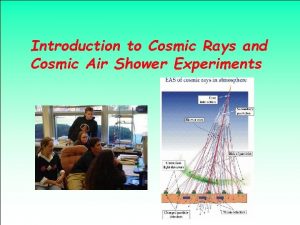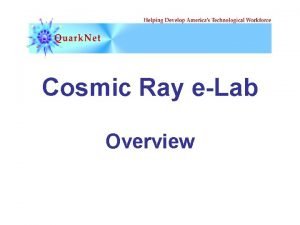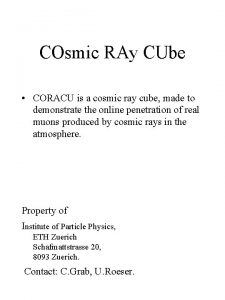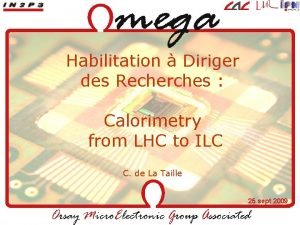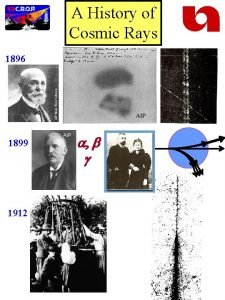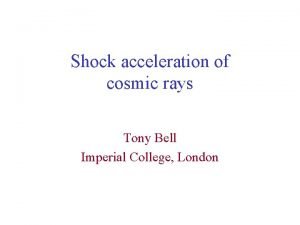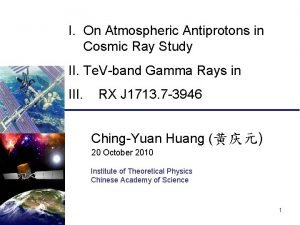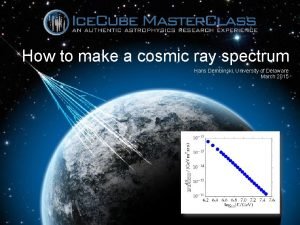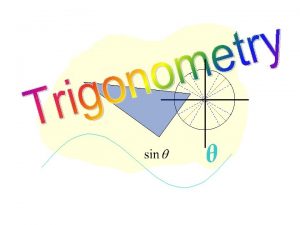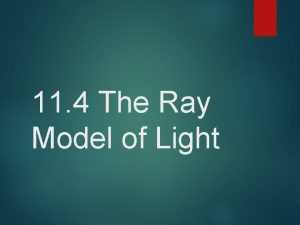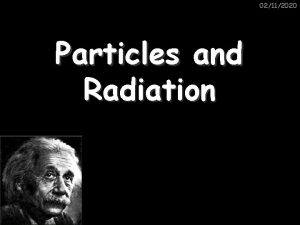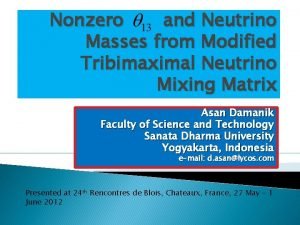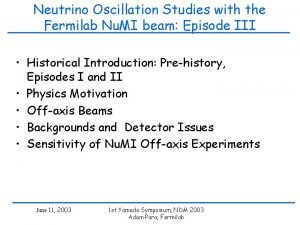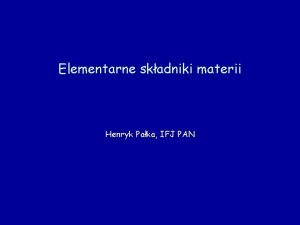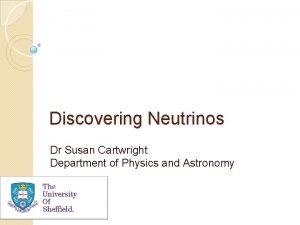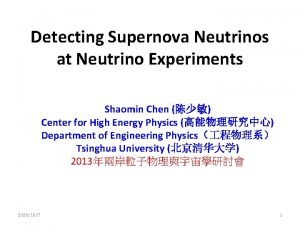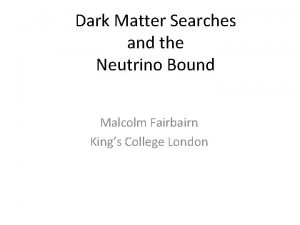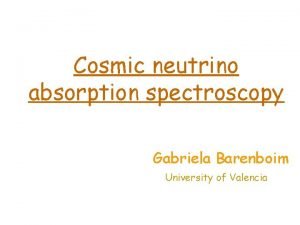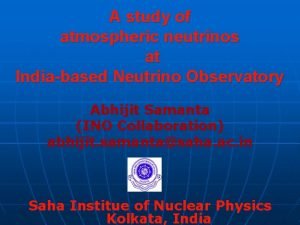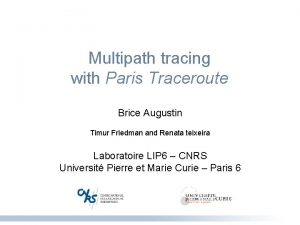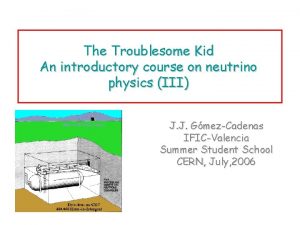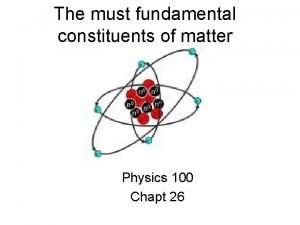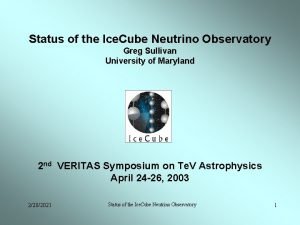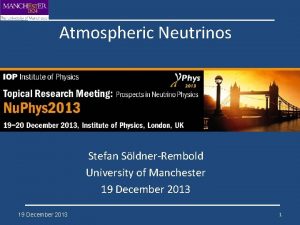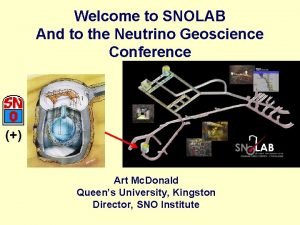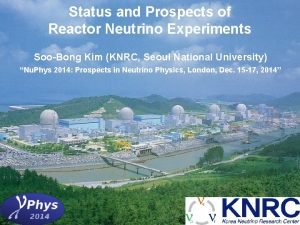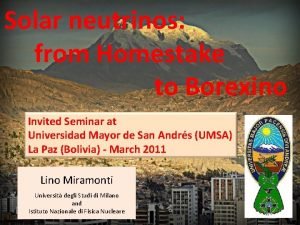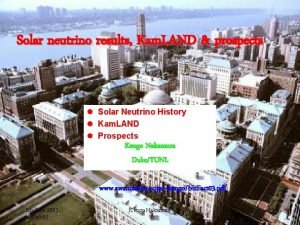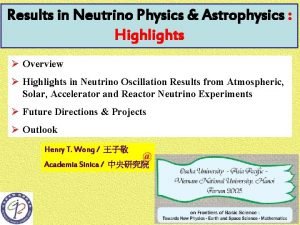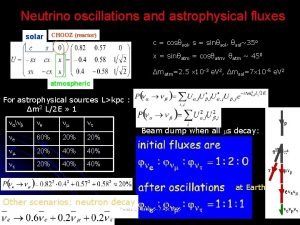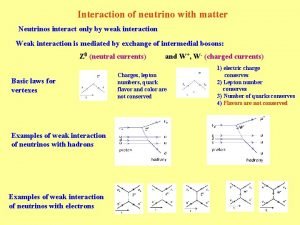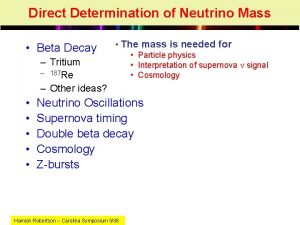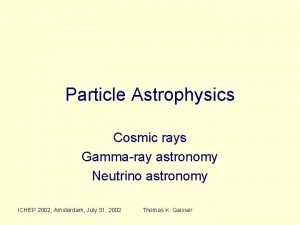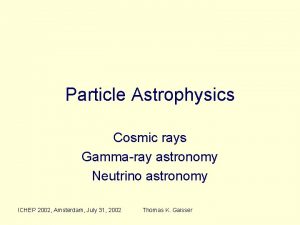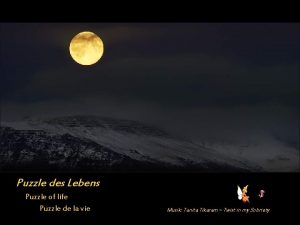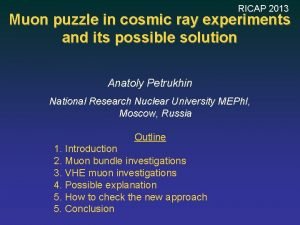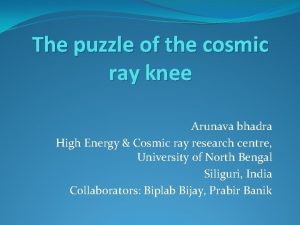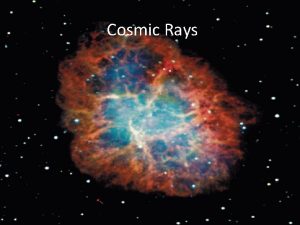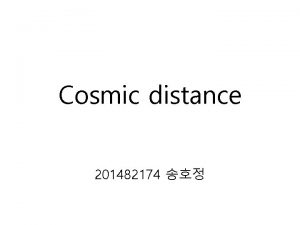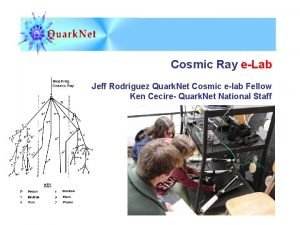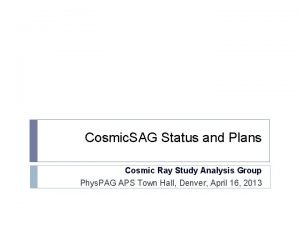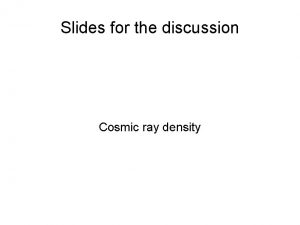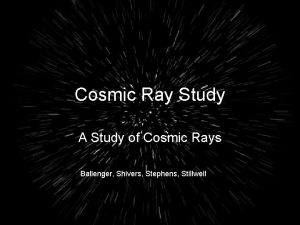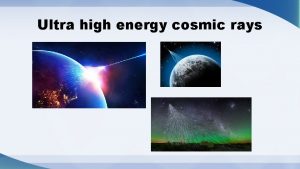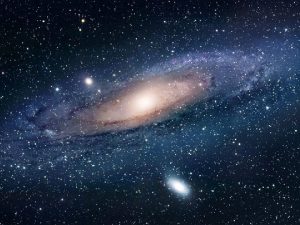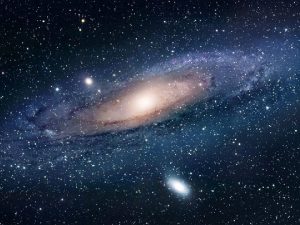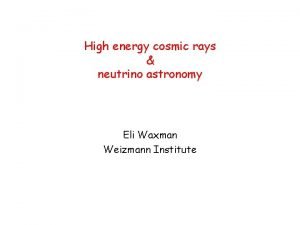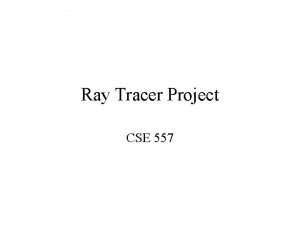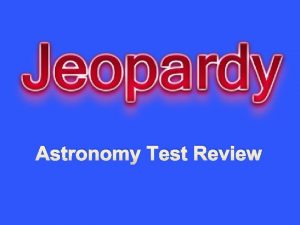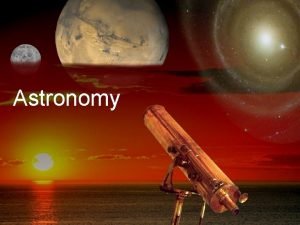Neutrino Astronomy introduction the cosmic ray puzzle revisited









![Multi-Messenger Astronomy Protons, -rays, neutrinos, [gravitational waves] as probes of the high-energy Universe 1. Multi-Messenger Astronomy Protons, -rays, neutrinos, [gravitational waves] as probes of the high-energy Universe 1.](https://slidetodoc.com/presentation_image_h/eb0664f15d435900ddb2b3def29b3594/image-10.jpg)
























































- Slides: 66

Neutrino Astronomy • introduction • the cosmic ray puzzle revisited • theory of high energy neutrino detection

Neutrino Sources • generic neutrino flux associated with the sources of the cosmic rays: 1. point 2. diffuse source • one example: gamma ray bursts • other science, one example: the search for dark matter

Neutrino Telescopes • First generation: AMANDA • Kilometer-scale neutrino observatory: Ice. Cube

Visible CMB 400 microwave photons per cm 3 1 Te. V = 1 Fermilab Ge. V -rays Flux Radio Energy (e. V)

With 103 Te. V energy, photons do not reach us from the edge of our galaxy because of their small mean free path in the microwave background. g + g CMB + e + e

/ / / Te. V sources! / / / cosmic / / rays / / /

Proton Astronomy? d. B d ____ ~ q = = E Rgyro ___ ~ 0. 1 o = [ d ______ 1 Mpc ][ B ______ 10 -9 G ] E _____ 3 x 1020 e. V B ~ 10 -6 Gauss in local cluster?

Interaction length of protons in microwave background p + g. CMB p+n l p = (�n. CMB ps+ CMB ) -1 @ 10 Mpc GZK cutoff above ~ 50 Ee. V

1000 Mpc 10 Mpc gamma ray bursts closest active galaxies local supecluster Virgo 1 pc ~ 3 ly ~ 1018 cm 1 Mpc 100 kpc halo 10 kpc 1 kpc 0. 1 kpc center of galaxy (scale height)
![MultiMessenger Astronomy Protons rays neutrinos gravitational waves as probes of the highenergy Universe 1 Multi-Messenger Astronomy Protons, -rays, neutrinos, [gravitational waves] as probes of the high-energy Universe 1.](https://slidetodoc.com/presentation_image_h/eb0664f15d435900ddb2b3def29b3594/image-10.jpg)
Multi-Messenger Astronomy Protons, -rays, neutrinos, [gravitational waves] as probes of the high-energy Universe 1. Protons: directions scrambled by magnetic fields n 2. -rays : straight-line propagation but reprocessed in the sources extragalactic backgrounds absorb E > Te. V 3. Neutrinos: straight-line propagation, unabsorbed, but difficult to detect

New Window on Universe? Expect Surprises

Knee of spectrum • Differential spectral index changes at ~ 3 x 1015 e. V – a = 2. 7 a = 3. 0 – Continues to 3 x 1018 e. V – Expect exp{-E / Z Emax} cutoff for each Z • Fine-tuning problem: – to match smoothly a new source with a steeper spectrum (Axford) – How serious is this? Knee

Transition to extragalactic origin? • Ankle new population of particles? • Suggestive evidence: Ankle New component with hard spectrum? – hardening of spectrum – change of composition • Measurements: – Energy – Depth of maximum (Xmax) – Nm / N e

Generic Spectrum with Cosmological Evolution sources evolve ~(1+z)3

Energy Spectrum by AGASA (θ< 45) 10 obs. / 1. 6 exp. 4. 0σ

Models of Cosmic Rays Bottom up – GRB fireballs – Jets in active galaxies – Accretion shocks in galaxy clusters – Galaxy mergers – Young supernova remnants – Pulsars, Magnetars – Mini-quasars – … • Observed showers either protons (or nuclei) Top-down – Radiation from topological defects – Decays of massive relic particles in Galactic halo – Resonant neutrino interactions on relic n’s (Zbursts) • Mostly pions (neutrinos, photons, not protons) Disfavored! • Highest energy cosmic rays are not gamma rays • Overproduce Te. V-neutrinos

Acceleration to 1021 e. V? ~102 Joules ~ 0. 01 MGUT dense regions with exceptional gravitational force creating relativistic flows of charged particles, e. g. • coalescing black holes/neutron stars • dense cores of exploding stars • supermassive black holes

Cas. A Supernova Remnant in X-rays Shock fronts Fermi acceleration John Hughes, Rutgers, NASA

Active Galaxies: Jets 20 Te. V gamma rays Higher energies obscured by IR light VLA image of Cygnus A

Jets Shock fronts Fermi acceleration Black Hole Accretion Disk

Challenge I: Acceleration shock velocity R B = boosted energy G from cosmic accelerator (V = e F; = v/c)

Superluminal motion: boosted accelerators 5 c 4 c 1 c 3 c telescope: 1 year later Eobs = G E' Dtobs = G-1 Dt' ' accelerator frame exp: G < ~ 10 3 ly light from blob is only 1 year behind that from agn!

Cosmic Accelerators E ~ Gc. BR R~ 2 GM/c energy magnetic field E ~ GBM boost factor mass

E (e. V) = B (Tesla) ms-pulsar 10 km 108 T 103 R B T-1 (#revs-1) E 1019 e. V R 2 2__p (m) T Fermilab few km few T 105 ~1012 e. V= 1 Te. V

E ~ G B M E > 1019 e. V ? • quasars • blasars • neutron stars black holes. . • grb G@1 > ~ 10 G@1 B @ 103 G M @� 109 Msun B @ 1012 G M @ Msun 2 > �� 10 ~ emit highest energy ’s!

cosmic neutrinos associated with cosmic rays

black hole radiation enveloping black hole p + -> n + p+ ~ cosmic ray + neutrino -> p + p 0 ~ cosmic ray + gamma

Irrespective of the cosmic-ray sources, some fraction will produce pions (and neutrinos) as they escape from the acceleration site • through hadronic collisions with gas • through photoproduction with ambient photons Cosmic rays interact with interstellar light/matter even if they escape the source Sources: • Transparent: protons (Ee. V cosmic-rays) ~ photons (Te. V point sources) ~neutrinos • Obscured sources • Hidden sources Unlike gammas, neutrinos provide unambiguous evidence for cosmic ray acceleration!

Requires kilometer-scale neutrino detectors

active galaxy Radiation field: Ask astronomers Produces cosmic ray beam?

Galactic Beam Dump

Modeling yields the same conclusion: • Line-emitting quasars such as 3 C 279 Beam: blazar jet with equal power in electrons and protons Target: external quasi-isotropic radiation • Supernova remnants such as RX 1713. 7 -3946 (? ) Beam: shock in interstellar medium Target: molecular cloud Nevents ~ 10 -2 -1 km year

neutrinos associated with the source of the cosmic rays? even neutrons do not escape neutrons escape

• Infrequently, a cosmic neutrino is captured in the ice, i. e. the neutrino interacts with an ice nucleus • In the crash a muon (or electron, or tau) is produced Cerenkov muon or tau light cone Detector • The muon radiates blue light in its wake • Optical sensors capture (and map) the light interaction neutrino

Optical Module

Use the phenomenon of Cherenkov light How to build a n detector?

Copyright © 2001 Purdue University

• Infrequently, a cosmic neutrino is captured in the ice, i. e. the neutrino interacts with an ice nucleus • In the crash a muon (or electron, or tau) is produced Cherenkov muon or tau light cone Detector • The muon radiates blue light in its wake • Optical sensors capture (and map) the light interaction neutrino

South Pole AMANDA– 1 mile deep

50 m Size perspective

• Construction began in 1995 (4 strings) • AMANDA-II completed in 2000 (19 strings total) • 677 optical modules • 200 m across • ~500 m tall (most densely instrumented volume) the AMANDA detector

AMANDA Event Signatures: Muons charged current muon neutrino interaction track nm + N m + X

Two events. . . 200 Te. V e candidate

Detection of e , , O(km) long muon tracks Electromagnetic and hadronic cascades 15 m direction determination by cherenkov light timing ~5 m

Optical Cherenkov Neutrino Telescope Projects ANTARES La-Seyne-sur-Mer, France NEMO Catania, Italy NESTOR BAIKAL Russia DUMAND Hawaii (cancelled 1995) Pylos, Greece AMANDA, South Pole, Antarctica

Northern hemisphere detectors Baikal NT 200 1100 m deep data taking since 1998 new: 3 distant strings Antares March 17, 2003 2 strings connected 2400 m deep completion: start 2006 Nestor March 29, 2003 1 of 12 floors deployed 4000 m deep completion: 2006

• 12 lines • 25 storeys / line • 3 PMT / storey ANTARES Layout 14. 5 m 350 m 100 m Junction box 40 km to shore ~60 -75 m Readout cables

GZK Cosmic Rays & Neutrinos • Cosmogenic Neutrinos are Guaranteed if primaries Nucleons. • May be much larger fluxes, for some models, such as topological defects p + g. CMB p + ….

Radio Emission from neutrinoinduced electromagnetic cascades • Electromagnetic cascades: electron-positron pairs and (mostly) gammas electrically neutral, no radio emission. • Compton scattering of photons on atomic electrons creates negative charge excess of ~ 20% • Negative charge radiates coherently at MHz ~ GHz Power = Energy 2 • Askarian effect demonstrated at SLAC: consistent with calculations

RICE Radio Detection in South Pole Ice Neutrino enters ice Neutrino interacts Antenna & Cable • Installed ~15 antennas few hundred m depth with AMANDA strings. • Tests and data since 1996. • Most events due to local radio noise, few candidates. • Continuing to take data, and first limits prepared. • Proposal to Piggyback with ICECUBE Cube is. 6 km on side Two cones show 3 d. B signal strength

ANITA Radio from Ee. V ν’s in Polar Ice • NASA proposal now • Data in 2005 if successful

Tau. Watch Using Mountains to Convert ντ 3/02 Workshop in Taiwan, see http: //hep 1. phys. ntu. edu. tw/vhetnw

Ocean Acoustic Detection New Stanford Effort using US Navy Array US Navy acoustic tracking range in Tongue of the Ocean, Atlantic Hydrophones 1550 -1600 m deep pancake beam pattern G. Gratta, atro-ph/0104033

Compare Potential GZK Neutrino Detectors

notes to previous table

Event Rates volume • OWL 1013 ton • Ice. Cube 109 ton eff. area 106 km 2 1 km 2 Events per year • OWL ne • Ice Cube nm TD 16 11 zburst 9 30 threshold 3 x 1019 e. V 1015 e. V* p 2. 7 5 1. 5 Cline, Stecker astroph 0003459 Alvarez-Muniz astroph 0007329 Warning: models identical? *actual threshold ~100 Ge. V, > 1 Pe. V no atmospheric n background

l n Psurvival = exp -(l/ ln) ln = n sn (En) The Earth as a cosmic ray muon filter n = NA

Neutrino Detection Probability neutrino detected neutrino survives - e L L _ ln ne m t nm nt for nm : L Rm [Em = (1 - y) En] for nt : L E __t mt c t t - 1 -e L _ ln L ~ _ _ ln Pdet= n. L sn

Range of the Muon d. E ___m = - ( a m + b m E m ) (R m ) d. Rm 2 Me. V cm 2/g low Em large Em 6 x 10 -6 cm 2/g (0. 8 x 10 -6 for t) E m ___ ~ _ Rm am Em = 5 m Ge. V 1 E n ___ ~ _ Rm ln ( ) bm Em

Energy reconstruction • Energy reconstruction will be a powerful tool in order to discriminate between astrophysical neutrinos and those coming from atmospheric interactions. • The muon energy reconstruction is based on the fact that the higher its energy, the higher the energy loss along its track. • The method is only valid above the critical energy ( 600 Ge. V), where energy losses caused by radiative processes dominate over ionisation processes. : ionisation : radiative processes

Neutrino Astronomy Explores Higher Dimensions 100 x σSM GZK range

Detection of n(En) Nevents = Psurvival Pdetected Area n Area = L 2 for detailed geometry and kinematics: Physics Reports 258 (3), 173 (1995) hep-ph/0105067

sn secondary lepton l (k') (1 - y) E = E' n(k) _ M 2 Q 2 = - (k - k')2 ~ W y. E p hadronic shower q(x) 2 s 2 d G _____ ___F dxd. Q 2 = p 2 M _____ W [ Q 2 + M 2 ]2 q( x, Q 2 ) W

sn 2 s 2 d G _____ ___F = 2 dxd. Q p 2 M W [ _____ Q 2 + M 2 W ]2 q ( x, Q 2 ) d 2 s _____ dxd. Q 2 M 2 W x q(x) x-l Q 2 QCD evolution Increasing Q 2 x M 2 W


 Math lesson
Math lesson Random sampling over joins revisited
Random sampling over joins revisited Cosmic address order
Cosmic address order Learning astronomy by doing astronomy
Learning astronomy by doing astronomy Learning astronomy by doing astronomy activity 7 answers
Learning astronomy by doing astronomy activity 7 answers Learning astronomy by doing astronomy activity 1 answers
Learning astronomy by doing astronomy activity 1 answers Cosmic ray showers
Cosmic ray showers Cosmic ray elab
Cosmic ray elab Coracu
Coracu Bit flip cosmic ray
Bit flip cosmic ray Cosmic ray
Cosmic ray Cosmic ray spectrum
Cosmic ray spectrum Cosmic ray
Cosmic ray Cosmic ray
Cosmic ray Tan 30 degrees unit circle
Tan 30 degrees unit circle Ray ray model
Ray ray model Ray tracing and ray casting
Ray tracing and ray casting Neutrino beteckning
Neutrino beteckning The leptons
The leptons Emission spectrum of sodium
Emission spectrum of sodium Neutrino
Neutrino Neutrino
Neutrino Lekka cząstka elementarna mion elektron lub neutrino
Lekka cząstka elementarna mion elektron lub neutrino Susan b. cartwright
Susan b. cartwright Neutrino
Neutrino Neutrino
Neutrino Neutrino density
Neutrino density Neutrino
Neutrino Paris traceroute
Paris traceroute Neutrino
Neutrino Neutrino symbol
Neutrino symbol Neutrino
Neutrino Neutrino
Neutrino Cerenkov
Cerenkov Neutrino
Neutrino Solar neutrino
Solar neutrino Nakamura
Nakamura Neutrino mass
Neutrino mass Neutrino
Neutrino Neutrino interaction with matter
Neutrino interaction with matter Neutrino mass
Neutrino mass Hát kết hợp bộ gõ cơ thể
Hát kết hợp bộ gõ cơ thể Frameset trong html5
Frameset trong html5 Bổ thể
Bổ thể Tỉ lệ cơ thể trẻ em
Tỉ lệ cơ thể trẻ em Voi kéo gỗ như thế nào
Voi kéo gỗ như thế nào Tư thế worm breton là gì
Tư thế worm breton là gì Bài hát chúa yêu trần thế alleluia
Bài hát chúa yêu trần thế alleluia Môn thể thao bắt đầu bằng từ chạy
Môn thể thao bắt đầu bằng từ chạy Thế nào là hệ số cao nhất
Thế nào là hệ số cao nhất Các châu lục và đại dương trên thế giới
Các châu lục và đại dương trên thế giới Công thức tính độ biến thiên đông lượng
Công thức tính độ biến thiên đông lượng Trời xanh đây là của chúng ta thể thơ
Trời xanh đây là của chúng ta thể thơ Cách giải mật thư tọa độ
Cách giải mật thư tọa độ Phép trừ bù
Phép trừ bù Phản ứng thế ankan
Phản ứng thế ankan Các châu lục và đại dương trên thế giới
Các châu lục và đại dương trên thế giới Thể thơ truyền thống
Thể thơ truyền thống Quá trình desamine hóa có thể tạo ra
Quá trình desamine hóa có thể tạo ra Một số thể thơ truyền thống
Một số thể thơ truyền thống Bàn tay mà dây bẩn
Bàn tay mà dây bẩn Vẽ hình chiếu vuông góc của vật thể sau
Vẽ hình chiếu vuông góc của vật thể sau Thế nào là sự mỏi cơ
Thế nào là sự mỏi cơ đặc điểm cơ thể của người tối cổ
đặc điểm cơ thể của người tối cổ Ví dụ giọng cùng tên
Ví dụ giọng cùng tên Vẽ hình chiếu đứng bằng cạnh của vật thể
Vẽ hình chiếu đứng bằng cạnh của vật thể Fecboak
Fecboak
